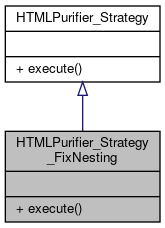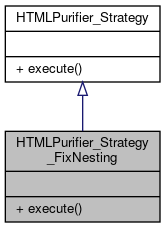Takes a well formed list of tokens and fixes their nesting. More...
 Inheritance diagram for HTMLPurifier_Strategy_FixNesting:
Inheritance diagram for HTMLPurifier_Strategy_FixNesting: Collaboration diagram for HTMLPurifier_Strategy_FixNesting:
Collaboration diagram for HTMLPurifier_Strategy_FixNesting:Public Member Functions | |
| execute ($tokens, $config, $context) | |
 Public Member Functions inherited from HTMLPurifier_Strategy Public Member Functions inherited from HTMLPurifier_Strategy | |
| execute ($tokens, $config, $context) | |
| Executes the strategy on the tokens. More... | |
Detailed Description
Takes a well formed list of tokens and fixes their nesting.
HTML elements dictate which elements are allowed to be their children, for example, you can't have a p tag in a span tag. Other elements have much more rigorous definitions: tables, for instance, require a specific order for their elements. There are also constraints not expressible by document type definitions, such as the chameleon nature of ins/del tags and global child exclusions.
The first major objective of this strategy is to iterate through all the nodes (not tokens) of the list of tokens and determine whether or not their children conform to the element's definition. If they do not, the child definition may optionally supply an amended list of elements that is valid or require that the entire node be deleted (and the previous node rescanned).
The second objective is to ensure that explicitly excluded elements of an element do not appear in its children. Code that accomplishes this task is pervasive through the strategy, though the two are distinct tasks and could, theoretically, be seperated (although it's not recommended).
- Note
- Whether or not unrecognized children are silently dropped or translated into text depends on the child definitions.
- Todo:
- Enable nodes to be bubbled out of the structure.
- Warning
- This algorithm (though it may be hard to see) proceeds from a top-down fashion. Thus, parents are processed before children. This is easy to implement and has a nice effiency benefit, in that if a node is removed, we never waste any time processing it, but it also means that if a child changes in a non-encapsulated way (e.g. it is removed), we need to go back and reprocess the parent to see if those changes resulted in problems for the parent. See [BACKTRACK] for an example of this. In the current implementation, this backtracking can only be triggered when a node is removed and if that node was the sole node, the parent would need to be removed. As such, it is easy to see that backtracking only incurs constant overhead. If more sophisticated backtracking is implemented, care must be taken to avoid nontermination or exponential blowup.
Definition at line 47 of file FixNesting.php.
Member Function Documentation
◆ execute()
| HTMLPurifier_Strategy_FixNesting::execute | ( | $tokens, | |
| $config, | |||
| $context | |||
| ) |
The documentation for this class was generated from the following file:
- Services/Html/HtmlPurifier/library/HTMLPurifier/Strategy/FixNesting.php


